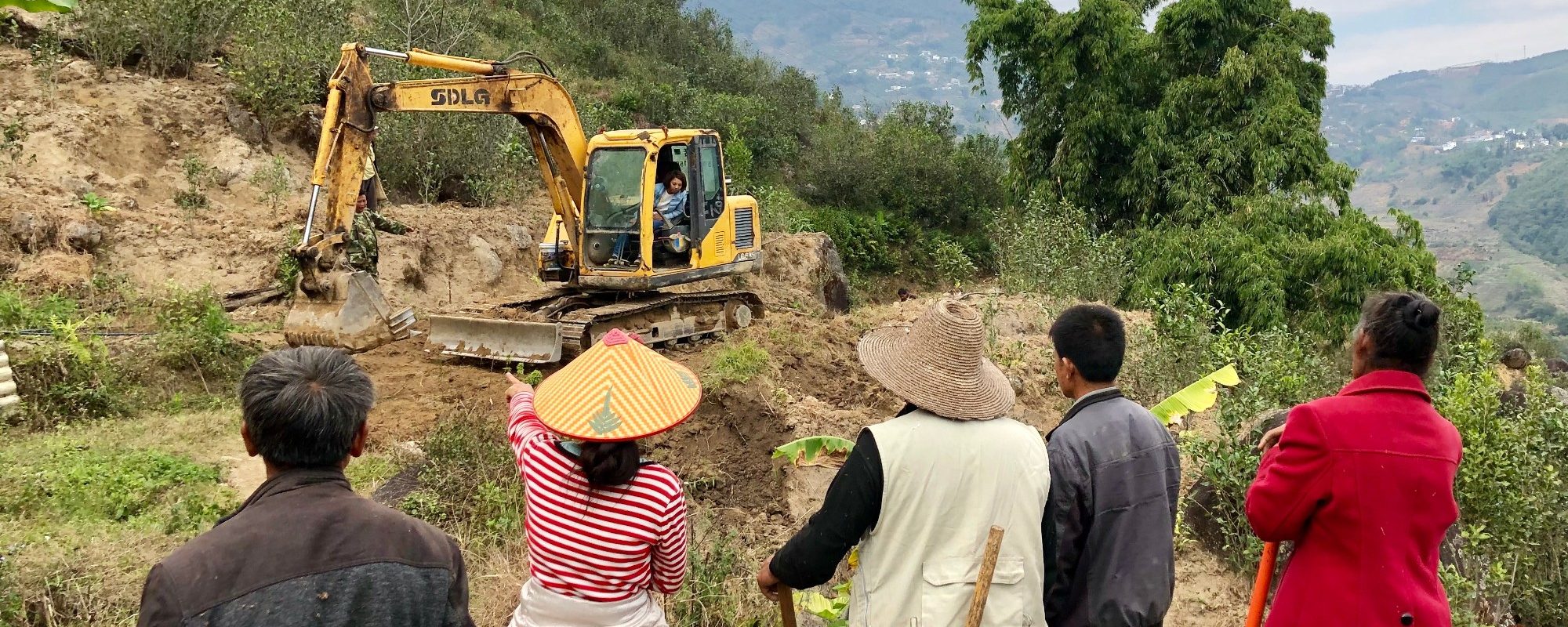BANGDONG, China — My stomach turned as I stepped aboard. It had been over ten years since my first overnight bus ride in China and the scene before me instantly brought back why that time had also been my last. Rows of metal bunk beds lined the windows on both sides of the bus and a third stretched down the middle. The beds were no wider than my shoulders, each with its own mint green travel pillow and folded orange blanket. The driver handed me a small plastic bag as I boarded, which seemed both thoughtful and ominous.
The bus bustled with activity as passengers settled in for the journey. Two university-aged girls stashed their name-brand shopping bags at the foot of their beds. Middle-aged men sprawled on their cots, faces glowing from their smartphones. Stockinged feet dangled from the top bunks. Tinny Chinese pop music filled the cabin as people munched on their standard bus station fare — sunflower seeds, spicy fried potatoes, processed sausages. The stale air, scented by musty bedding, sweaty feet, spicy sauce and savory meat, turned my stomach slightly more.
The aisles were each no more than a foot-and-a-half wide, so I shuffled sideways past threadbare socks and curious stares on my way to Bed 14. To my surprise, it was just about long enough for a ventriloquist’s dummy.
“I seem to have been assigned a child’s bed by accident,” I explained to the bus attendant with a hint of apprehension.
“No mistake,” she replied, the nuances of her local accent demanding my full attention. “The beds are all different sizes. Beds 32 to 36 are still empty. If they are bigger, you can change if you want.”
A decade ago, more than 40 percent of Yunnan’s rural population had no direct access to a paved road. But roads are now bringing unprecedented change.
I feared the worst as I squeezed down the far aisle once again. I’d heard of five-person beds in the back of buses where sardined strangers have to synchronize rolling over in the night. To my great relief, however, I found Bed 32, a top-window bunk, sized, incredibly, to my precise dimensions. My head and feet pressed up against their respective metal dividers, and my shoulders enjoyed a firm embrace from the side bars. But as I carefully wedged myself in for the journey, I couldn’t help but grin. This moment had been a long time coming: I was finally on the road.
I had lived in greater China for more than a decade, working in various sectors and different cities: Beijing, Shanghai, Nanjing and Taipei. I had learned Mandarin, earned a Masters degree in China studies and kept up with current events. I knew just enough to know how much I didn’t know about China. However, my experience had been overwhelmingly urban and the majority of voices that had informed my understanding of the country were urbanites: friends, academics and businesspeople with their own unique, but still urban, perspectives. A huge gap existed in my understanding of the rural population, which, at 590 million, still makes up almost half China’s total population.
As a fellow of the Institute of Current World Affairs, I was finally getting the chance to fill in that gap based high above the Mekong River in the tea mountains of China’s Yunnan Province. For the next two years, the region’s Bangdong village would be my home and its 350 residents my neighbors. I would learn first-hand about rural life and its transformation amid the country’s unprecedented infrastructure development and economic growth.
Yunnan is a special corner of China. Comparable in size and population to Spain, it is one of the country’s most ethnically and geographically diverse provinces. It boasts the highest number of ethnic groups and features both snow-capped Himalayan mountains to the north and tropics to the south along its border with Myanmar, Laos and Vietnam. Yunnan is also one of China’s poorest provinces. Because it is mountainous and landlocked, arable land and trade are limited. Only ten years ago, over 40 percent of the region’s rural population had no direct access to a paved road. It is a world apart from the megacities I’ve lived in, to say the least.[modern_footnote]Hello Friend[/modern_footnote]
I’d first visited Bangdong village a year prior as I happened to be working on my application for an ICWA fellowship. The village pulsed with change amid roadwork and housing renovations. It seemed essentially a microcosm of the transformation at work in Yunnan Province and China at large. So I decided Bangdong would be a perfect home base in which to build friendships, make observations, ask questions and write. This overnight bus trip from the regional capital Kunming was my first step on a two-year journey.
Lying in Bed 32, I rolled over to face the window and pulled my stale orange blanket tight around my chin, my breath escaping in visible puffs. Nighttime enveloped the countryside, a stark contrast to the 24-hour neon buzz of the cities I knew. Shanghai’s futuristic skyline was far away, Beijing’s traffic jams a distant memory.
How will I be received in the village? Where will I live? What will my relationships look like? What is daily life like in Bangdong and how will that change over two years? How will I change?
My mind swirled with questions about the road ahead. I closed my eyes and smiled as lyrics from Whitesnake, the 1980s hair metal band, crooned in my head: “Here I go again on my own, I’m going down the only road I’ve ever known.” The bus rumbled on, quiet but for the soundtrack in my mind and a chorus of sunflower seeds cracking in the darkness.
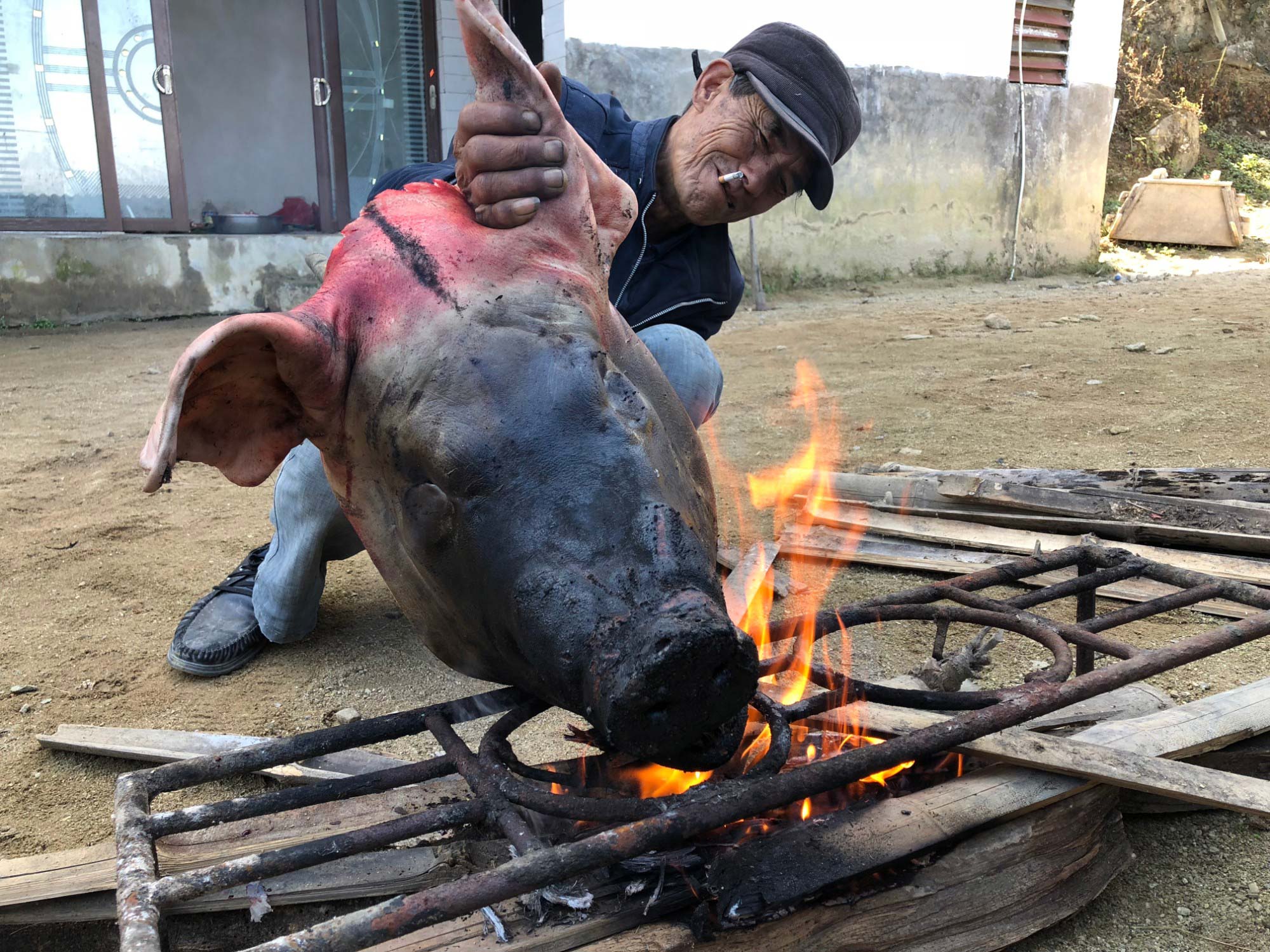
If you want to prosper, build a road
Wiping the condensation from my window at first light, I was greeted by a new world. The stereotypical drab of urban China had transformed into a lush landscape. Terrace after terrace of verdant crops and earthen walls layered the hillside, like a life-sized raised relief map covered in a massive green zebra pelt. Yellow daisies and purple bougainvillea whizzed by. I had actually slept well tucked away in my Matt-sized bunk, oblivious to the construction, traffic accident and standard 2-5 a.m. driver break that delayed us by hours. And I’d heard only one person making use of a plastic bag in the night.
After 15 hours, we arrived in Lincang, a nondescript third-tier Chinese city of 350,000 and Bangdong’s nearest urban center. I transferred to a “bread car” (面包车), a mini-van so named for its resemblance to a loaf of bread. I prefer to call them “loaf vans.” Passengers courteously offered one another cigarettes while we waited to fill the seven seats, the maximum legal capacity. Driver Li makes only one round-trip per day so with $5 per person for the three-hour ride, he makes it a point to maximize his profits. Finally, with nine passengers and a trunk full of express packages, we set out.
We wound through sparse housing at the edge of a valley. Dogs and chickens meandered lazily across the asphalt. A pig squealed, wildly waving its four trotters in the air as six grown men held it down. ‘Tis the season to “kill the year pig” (杀年猪), a traditional winter block party to barbecue very fresh meat and prepare sausage and cured meat for the year to come.
The potholed road soon narrowed to a lane and a half and devolved into packed dirt and rock. Driver Li was in continuous motion. He honked at motorbikes that carried dad, mom and baby strapped in a papoose on back. He swerved around small freight trucks with mattresses and furniture. He cursed at cement trucks that didn’t yield fast or far enough for us to pass. We all bounced around like bobbleheads inside the loaf van while the cigarette on Driver Li’s bottom lip hung limply in place, apparently impervious to the excitement.
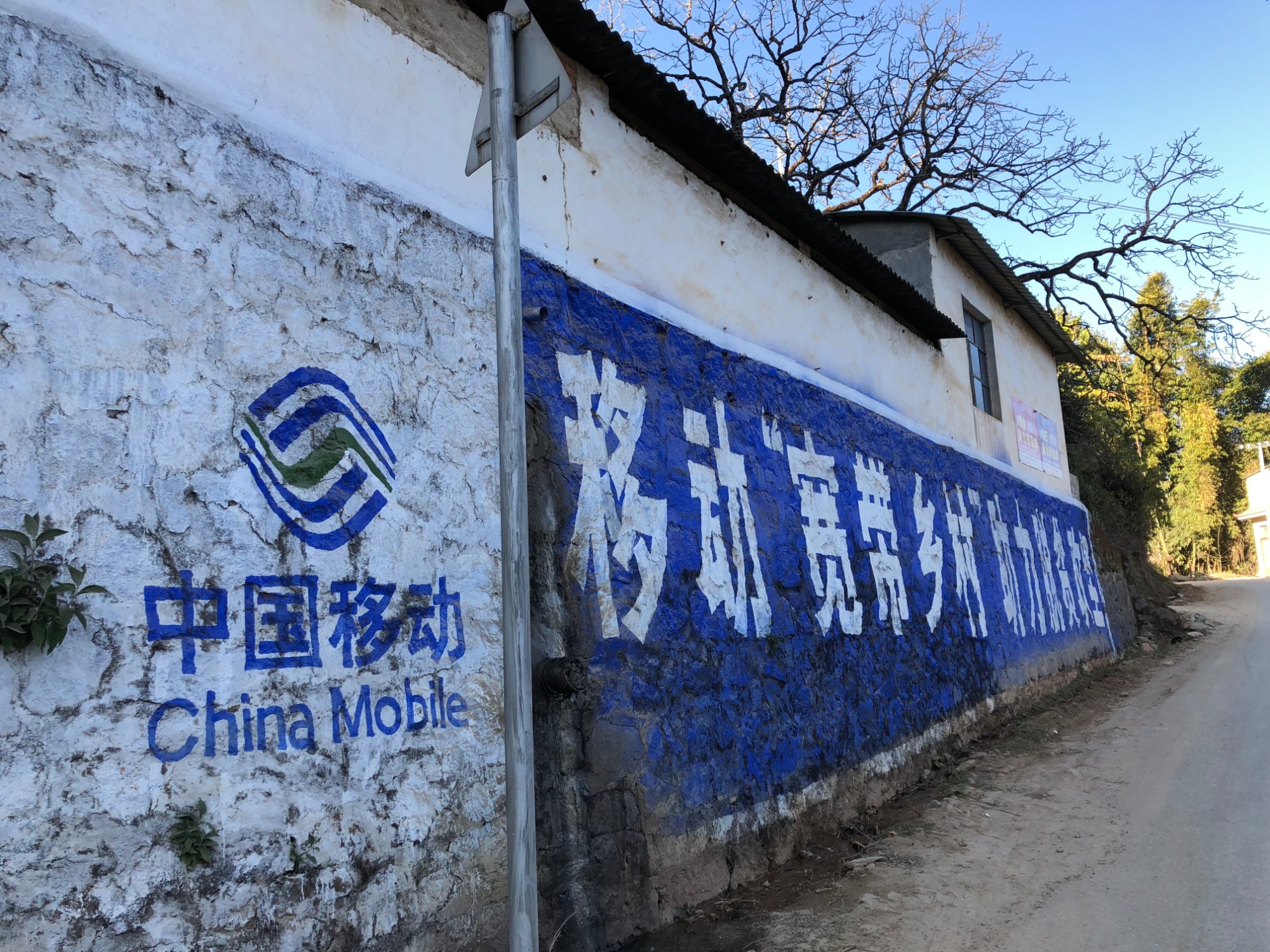
We followed the dirt road along a stream and up through a mountain pass. Piles of rock and brick lay waiting to upgrade retaining walls or replace derelict wooden structures. Cherry blossoms and feathery bamboo fronds blurred by us along with painted slogans in blue and white, red and yellow, white and green.
“China Mobile’s ‘broadband villages’ advance the assault on poverty.”
“For strength and reliability, think Time Aluminum. ISO9001 certified.”
“To see an OB/GYN or have an abortion, go to Yunzhou Hospital.”
“Continue the fight to realize the Chinese dream of the great revival of the Chinese nation.”
“If you want to prosper, first build a road.”
And building a road they are. The Yu-Lin Highway, the multi-billion yuan cross-region artery I mentioned in my introductory blog post—which last spring amounted to nothing more than concrete pylons—now actually resembles a freeway. It has already dramatically altered the physical landscape as well as the expectations of those living in the region. When it opens in 2020, what is now a three-hour roller coaster ride from Lincang will become a 30-minute scenic jaunt into the countryside. What ended up for me being a full 22 hours in transit from Kunming would become just a four-hour drive to the provincial capital. Bangdong tea and coffee, once off the grid and inaccessible deep in China’s hinterland, are poised for new markets. Moreover, Bangdong itself is ripe for one of the most transformative forces in Yunnan’s economy: tourism dollars. That force is already hard at work across the province, from the ethnically Tibetan town of Shangri-La in the Himalayas to the Dai Ethnic Village in tropical Xishuangbanna, along with every old town heritage site and minority village in between.
Roads are bringing unprecedented change to Yunnan, which is what I’m here to observe. It was almost poetic, then, that I covered the final stretch of the road to Bangdong by hitching a ride with three twenty-somethings working construction on the Yu-Lin Highway. My loaf van had stopped at the end of its route in the town of Potou, still six miles from Bangdong village, so I stood on the corner with a hopeful thumb raised. The three young men—headed home from weeks on the construction site for a three-day break with their wives and children—welcomed me into their truck with curious grins and courtesy cigarettes. The very hands forging the transformation across Yunnan delivered me down the final stretch of road. I arrived in Bangdong with a suitcase, backpack and ukulele, exhausted and happy to be “home.” The village mayor, Zhu Hong, came out to greet me with his characteristic grin. “Good morning!” he said in English. It was eight o’clock at night and I was ready for a real bed.
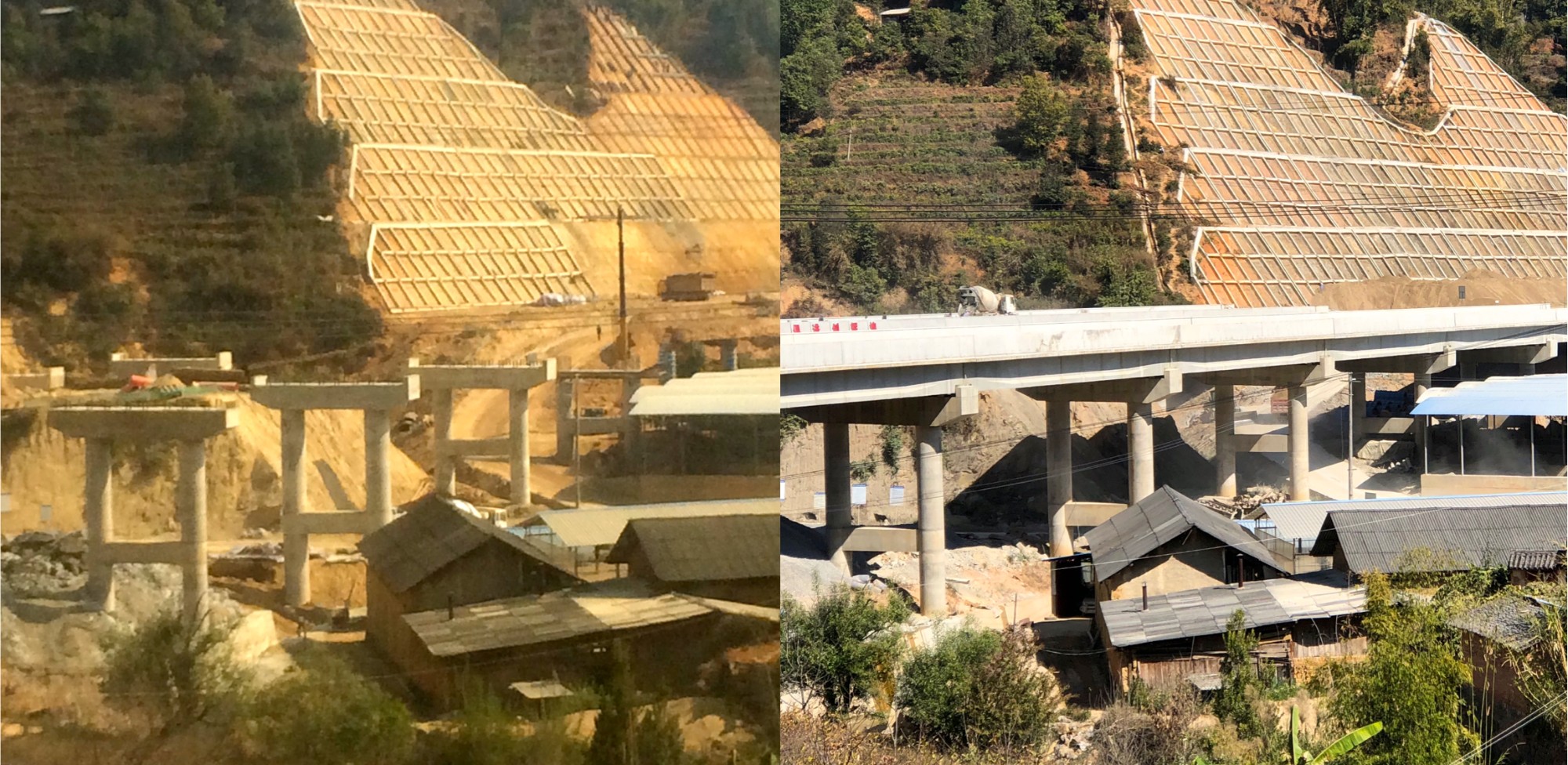
The international big dirt road
Village Orientation 101 began the next morning, not with a PowerPoint, but a hoe. Zhu Hong handed me the tool greeting me with a hearty “Good night!” His word choice was less a function of bad English and more of his quirky sense of humor. He has a penchant for laughter and his smile flashed white against his dark skin, evidence of a childhood in the countryside sun.
Zhu Hong is unconventional in other ways. At around five foot three, he is an unimposing figure with shoulder length hair usually styled in a fashionable ponytail or man-bun. His interests and ideas have made him a sort of Bangdong Renaissance man. He waxes Daoist philosophy over homegrown coffee. He greets the morning sea of clouds with his wooden flute. He gathers friends for traditional tea ceremonies and hand-drum circles. He decorates his home with his own pottery and calligraphy.
Zhu Hong’s unconventional ideas prompted him to leave his traditional “backward” village at the age of 15. With the equivalent of $5 in his pocket, he set out to seek his fortune—unbeknown to his parents—in the factories of Guangzhou, the southern port city. Seemingly a lifetime later, at the age of 31—after years of factories, gangs, dreadlocks, bands, artisans, free spirits and lost souls—Zhu Hong permanently returned to his village. His parents were aging and life in the city had given him a new appreciation for idyllic rural life. He returned home with new ideas and resources from the outside to make Bangdong better. His initiative got him unwittingly elected as village mayor in 2016 while he was out of town. The previous mayor called to share the news: “Come back, you’ve already been mayor for three days now. Time to get to work!”
Yunnan’s external trade is growing more 20 percent a year. It is no longer a dead end, but a bridge that’s increasingly critical for international trade and China’s continued economic growth.
Today’s collective workday was Zhu Hong’s idea. The village had harvested trees from village land, and rather than evenly distributing small change to each villager, he put the money into a village fund. It enabled Bangdong to hire an excavator and operator from a nearby village to build a new production road that would provide Bangdong residents better access to their fields and a neighboring village. A small dirt trail already wound through the mountains, worn by years of villagers walking to and from their fields. This week’s goal was to turn that one-track trail into a dirt road wide enough for a truck.
Zhu Hong had rented the excavator for five days and expected each household to send a representative for at least two of those workdays. I joined about 20 villagers, young and old, hoes in hand, and headed out to the trail. The young men wore jean shorts and plastic shower sandals, their toes vulnerable to the tools cutting into the earth just inches away. Their fathers wore light jackets, jeans and camouflage canvas shoes. Several had machetes hanging off their belts behind them. The women were covered head to toe to protect from the sun, sporting an assortment of hats: pointy thatched hats, round straw hats, pink sun hats, a red fedora and a pink baseball cap with silver sequins reading “Girls Style Attitude Beauty.”
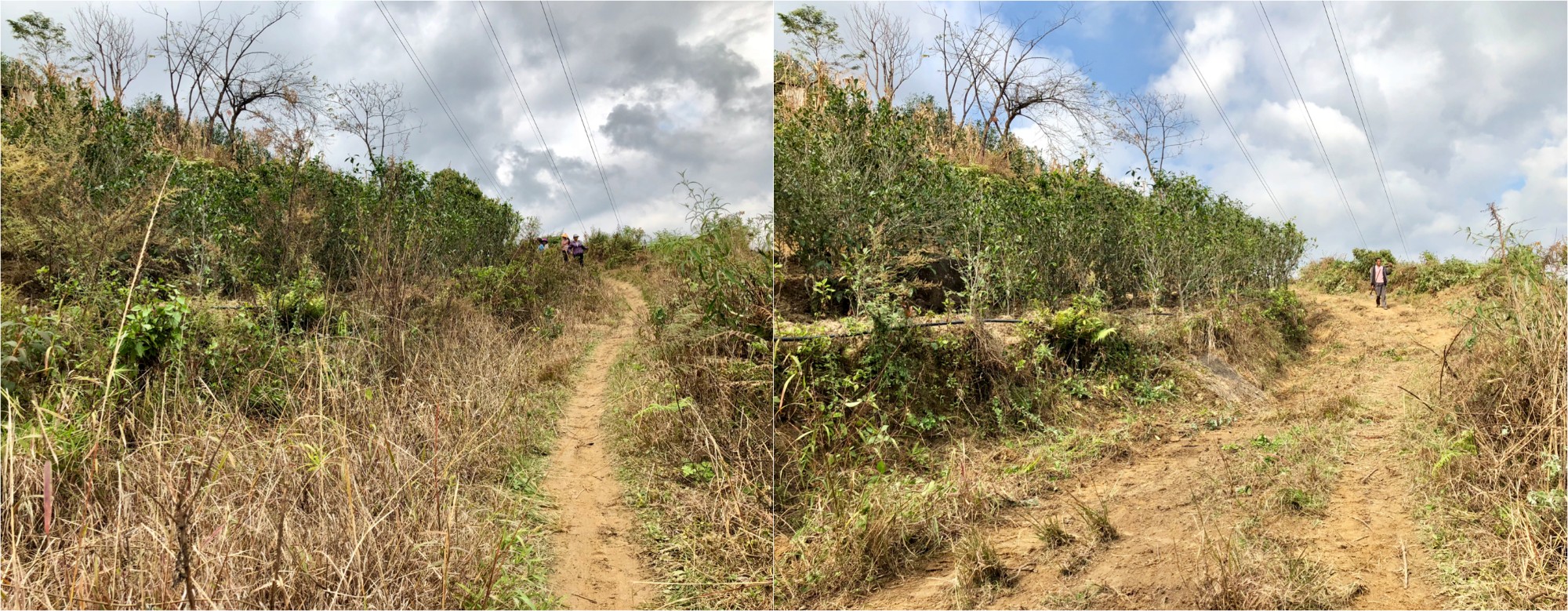
When we arrived, the excavator was already busy at work. A petite thirty-something lady in trendy ripped jeans and ankle-high fashion boots operated the controls to cut into the mountainside, dig out large rocks and flatten the ground. We moved in behind the excavator to clear brush and dig a drainage ditch for water runoff. The villagers’ movements were practiced and sure. Years of laboring in the fields had perfected their technique and toughened their hands. I, on the other hand, struggled to keep up, already feeling blisters forming on my hands.
“You Americans don’t have to work outside like this,” one of the villagers half-stated, half-asked in what was probably a reflection of my mediocre performance.
“The US is big like China and has cities and countryside both,” I explained. “I grew up in a more rural area so my family worked outside a lot. But that was 15 years ago!” I added, rubbing my already-sore back.
“Once every 15 years is good for you,” he joked. “Bangdong is proud of our bilateral cooperation with you to build our international big dirt road!”
Our numbers increased to over 30 as the day went on. Each new arrival prompted a flurry of cigarette exchanges. Often, only two or three people would be scooping dirt while everyone else leaned on hoes chitchatting and watching the excavator. Finally, one of the villagers—usually one of those still hoeing—would yell, “干活的,” the Chinese equivalent of “Get ‘er done!” And the dirt would start flying again.
There was a sense of purpose and, I dare say, comradery as we worked. Our huddled mass inched along behind the excavator, shoulder-to-shoulder, each digger removing several scoops of dirt before moving on. It was neither calculated nor coordinated, but somehow a foot-deep drainage ditch emerged in our wake.
Over the next five days, we cleared two miles of road and laid many drainage culverts along the way. I also got a handful of blisters and one really sore back. But I was struck most by subtle nuances in the notion of community service. I grew up doing community service projects for Honor Society and church youth group. But, looking back, I found the “community” dimension to those projects was often lacking. They were for people I didn’t know and would never see again. And they tended to be oriented around paternalistic serving rather than a joint investment in the community. The production road project was refreshing because it was the community’s own initiative and investment of time and money to improve the village—service of the people, by the people and for the people.
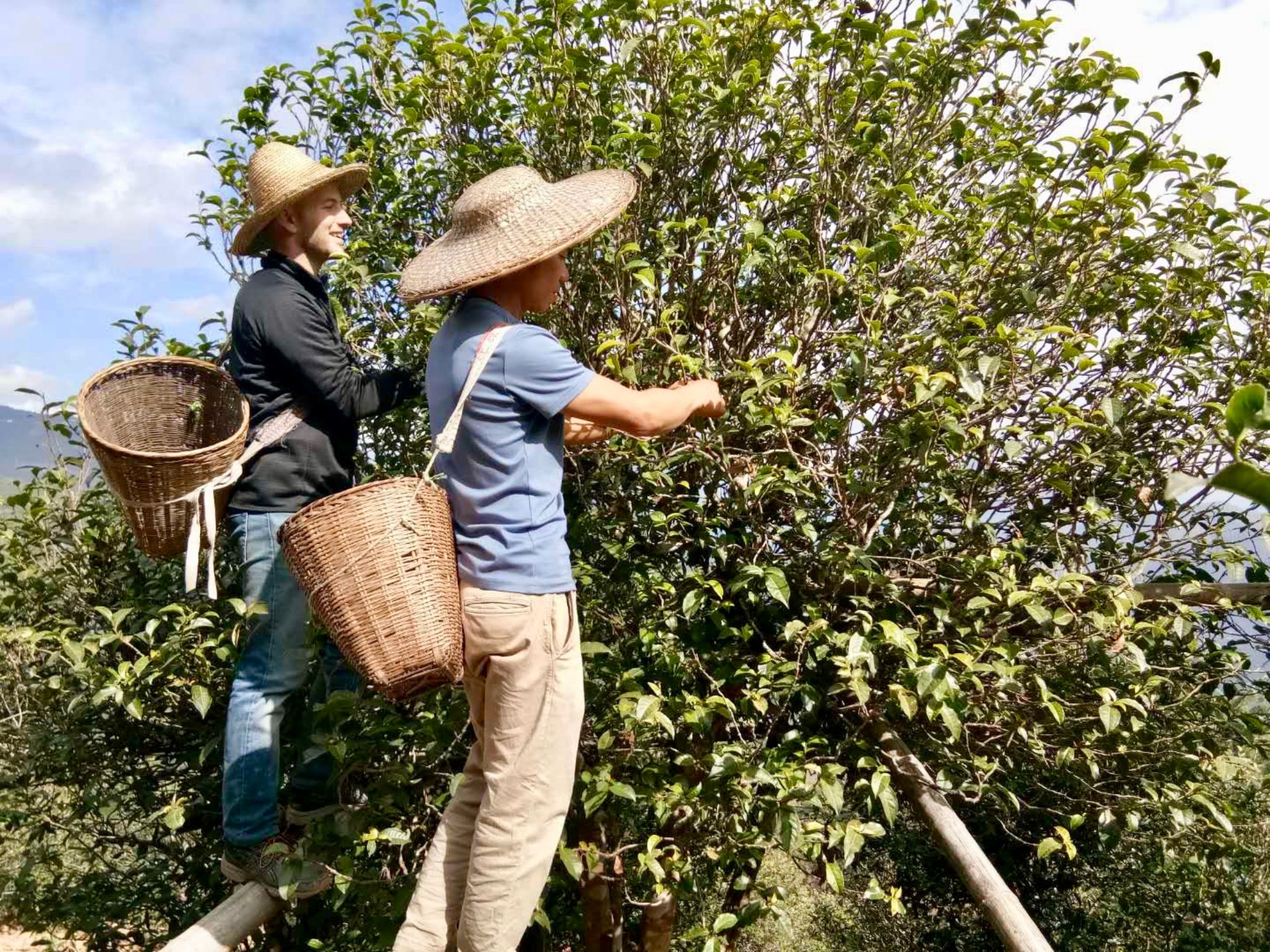
The following week, Zhu Hong explained the importance of the production road to a Lincang TV camera crew. Zhu Hong’s villager-turned-artisan persona has given him a measure of local celebrity, so villagers have become used to visiting film crews following him around the village. This particular reporting was for a special on Bangdong tea, good PR for the village. And a foreign friend doing manual labor in a pointy straw hat always makes for good television.
Zhu Hong and I, together with some other villagers, re-enacted digging the ditch as cameras captured the mayor’s explanation from three different angles. “Previously, we could access our crops only by foot and with these baskets,” he said. “It was a slow process and we could handle only small amounts. With this road, and the new roads and highways the government is building in our region, we can move our tea easily and in large amounts. It’s a game changer.”
In addition to providing improved access to markets for selling produce and purchasing agricultural inputs, the new roads and highways will also cut travel times and lower costs of accessing health facilities, schools and other important social services. The nearest health facilities are three hours away, forcing residents to delay treatment or resort to sub-par service from locals with limited medical training. Although the village itself boasts an elementary school, the junior high is in a township six miles away, where students often board and return only on weekends. Ambitious students who pursue high school education must board at school even further—three hours away in Lincang. Zhu Hong’s seven-year-old niece, Jiu Jiu, for one, lives in the city with her mother to attend a better elementary school. She returns to the village to see her father only on the occasional break from school. Such arrangements that separate immediate family for work or school are common in China.
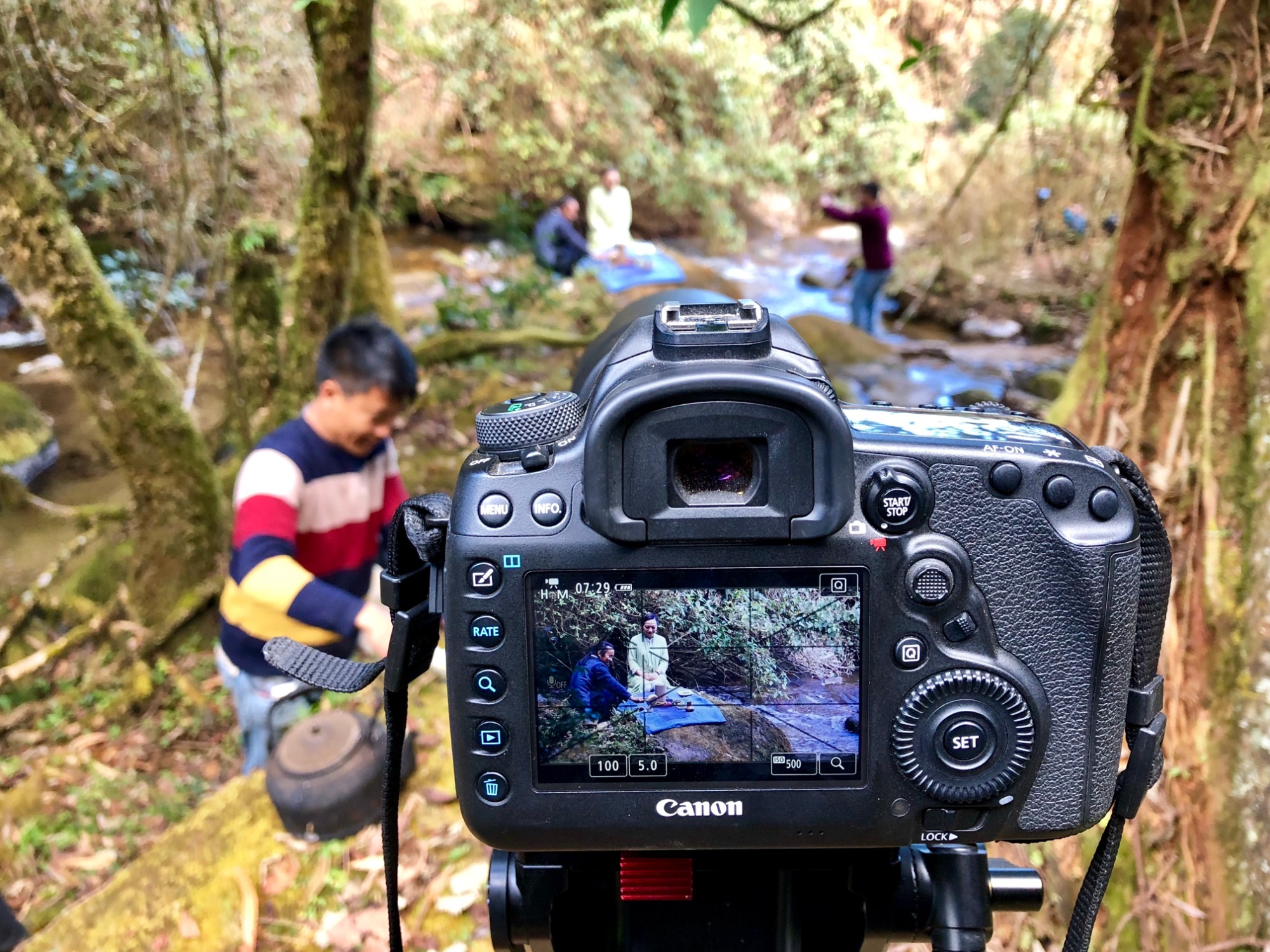
Roadology to enlightenment
Production roads like Bangdong’s and the prosperity they bring are not a new phenomenon, of course. Farm-to-market roads paved the way for modern agriculture in the United States. As technology and agricultural techniques advanced, farmers were able to work larger plots of land and provide for larger numbers of people. My own father grew up on a wheat farm in North Dakota in the early 1950s and recalls the significance of farm-to-market roads for his own rural community. “They crisscrossed the flat farmland about every mile or so,” he told me. “Some were no more than two-rut dirt tracks, but usually they were the only way to get our harvest to the nearest railroad line.”
The slogan “If you want to prosper, first build a road” isn’t just empty propaganda. Every five years, China’s central and provincial governments develop a plan outlining their economic and social initiatives for the next five years. Yunnan’s thirteenth five-year plan (2016-2020) allocated over $80 billion to road and waterway infrastructure investment. Yunnan plans to expand its provincial road network by 25 percent to 150,000 miles by 2020, and to connect every county by highway. The Party is putting its money where its mouth is.
Road infrastructure is central to the Communist Party’s strategy for eliminating poverty by 2020. In his 2018 New Year’s greetings, Chairman Xi Jinping reminded the nation of that ambitious goal as well as the progress already achieved. In 2017 alone, 10 million rural poor Chinese were lifted out of poverty and 3.4 million of those are celebrating the New Year in new homes thanks to government subsidies.
Many in Bangdong are included in that figure. And road money is reaching their village as well. While we were clearing the international big dirt road, a construction crew started pouring a concrete one in Bangdong. It will connect all the households in Bangdong, roughly a mile in length, and cost about $500 thousand of municipal and provincial government funding. Equipment and construction costs in hard-to-access rural areas are prohibitively expensive.
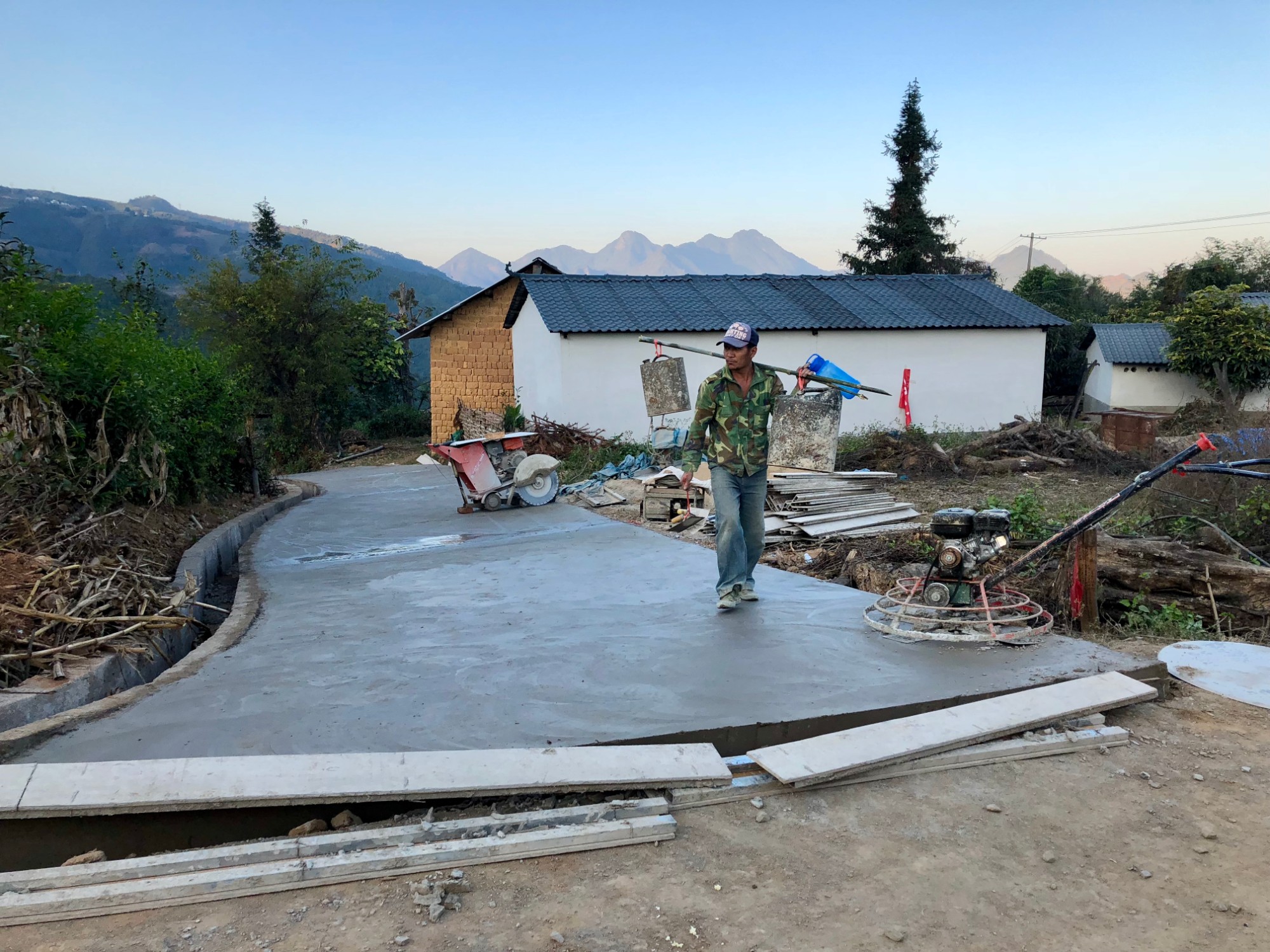
One local official who helped secure the funding is confident in the progress. Over a New Year’s barbecue at Zhu Hong’s, he shared the central vision. “About 80 percent of the roads in Yunnan are done and the government is committed to finishing the job,” he said. “It’s not a question of if or when, just how. Many households are spread out and hard to access, so it takes careful planning. But we will do it.”
The government’s focus is not just domestic. According to Yunnan’s “Seven Interprovincial and Five International Highways” plan (七出省五出境), roads will link not only every county in Yunnan but also neighboring countries. Construction has already begun on a Pan-Asian railway that will connect Yunnan with all Southeast Asia, running all the way to Singapore. Yunnan’s external trade is already growing rapidly at over 20 percent annually for most of the last 15 years. When those projects are completed, the region’s importance in China’s strategy for continued economic growth will only grow. Yunnan is no longer a dead end. It is a bridge, increasingly critical for international trade and China’s continued economic growth.
What Zhu Hong didn’t share with the television cameras is that roads are not a panacea for poverty alleviation. Beyond infrastructure development, rural areas have to work on productivity, quality of products and improving farming practices. Roads also bring bad with the good. They threaten natural environments and disrupt water drainage. They bring dust, noise pollution and traffic accidents. And they facilitate human and drug trafficking. Yunnan shares a porous 2,500-mile border with Myanmar, Laos and Vietnam and has to maintain an active guard against drugs, human trafficking, prostitution and the spread of HIV/AIDS, particularly at border crossings among long-distance truck driver populations. The multiple police drug checkpoints along my 22-hour bus ride to Bangdong reminded me of Yunnan’s unique reality.
Maintenance also presents a significant challenge. “China has made tremendous efforts in investing in the expansion of its transport infrastructure,” World Bank country director for China, Bert Hofman, shared in a recent statement on China-World Bank cooperation. “In the next phase, it will have to shift attention to maintaining those assets.” A two-year-old brick road built to connect Bangdong with its neighboring township already suffers deep ruts. Waves of brick roll across the road, evidence of the heavy traffic of trucks working construction on the Yu-Lin Highway.
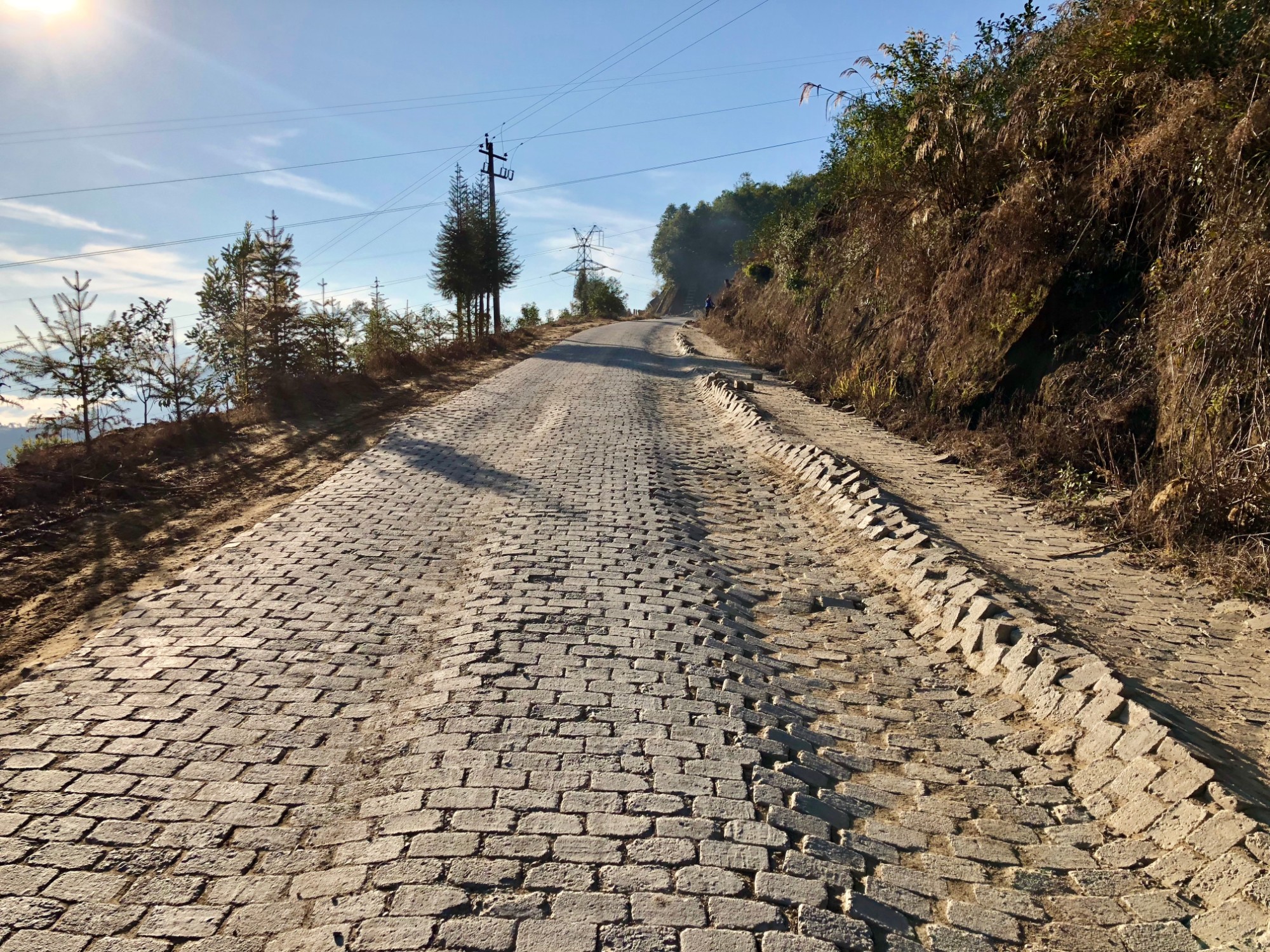
But there’s one concern for Bangdong that Zhu Hong worries about far more than dust, drugs or disrepair. He and I sit by his outdoor fireplace, a simple rectangle of brick three layers high. His hair hangs loosely to his shoulders, still wet from his evening shower, and he sports a name-brand mustard cardigan from his latest trip into the capital. A handmade clay pitcher sits in the flames as he roasts some tea for us from his latest crop.
As Zhu Hong stares into the fire, his expression turns contemplative, a rare departure from his usual levity. “I worry what this village will become in ten years,” he says. “I fear the roads will bring too much money. People here don’t know how to spend it—they’ve never had it. They spend it on big, ugly, empty houses. They’ll waste it on cars, gambling, women. No one will come out for village work days anymore.”
Already, the village is sending its crops and children down the road. Will its very identity follow?
Transportation brings transformation—for better or worse. Mass-scale road construction in China has spawned a nascent academic field to study that transformation, and along with it comes a cool new word: “roadology” (路学). Roadology gathers an interdisciplinary smattering of academics—anthropologists, ethno-historians, linguists, sociologists and geoscientists—to examine the relationship of roads to culture and the development of an area. Consider the Silk Road or Route 66 as conduits of culture and development. Or the farm-to-market “roads” that transformed the landscape of my father’s rural community in North Dakota.
Roadology is what brings me to Bangdong. Preparations are underway to construct the last 20 percent of roads that the government official spoke of. Most, if not all, will be built during the two years I’m here, right before my eyes. The very road that brought me to Bangdong—with its plastic bags and squealing pigs—will likely not be the same road that brings me home at the end of my journey.
As the fire shrank to glowing embers, I said goodnight to Zhu Hong. “Good morning,” he grinned back. I went for a walk along the road, a half-moon lighting my way across the waves of brick. I passed one of those big ugly empty houses that just last year was but a concrete foundation spewing rebar. Across the valley among twinkling house lights, a single red and green neon sign glowed, the first of its kind, also new since I last visited. Bangdong is changing. As I think about the two years ahead, I smile and wonder which of us will change more.

